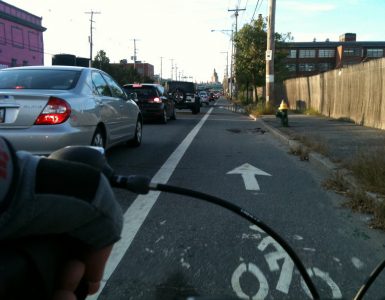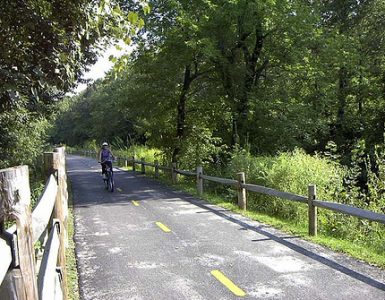Sharrows on a Seattle Street, Photo (cc) The Prudent Cyclist.
 Sharing time: Tracking the ‘sharrow’ on city streets [Grist]
Sharing time: Tracking the ‘sharrow’ on city streets [Grist]
Like many experts on transportation bicycling, Fucoloro wasn’t enthusiastic about them. Sharrows are spread so indiscriminately on Seattle streets, he said, that “they mean nothing now.” He has noticed that there seems to be “slightly less aggression” from drivers when they’re in place. “But does that mean all the streets without sharrows are worse?”
In other words, with sharrows everywhere, do drivers assume that cyclists don’t belong on streets without them?
Five myths about your gasoline taxes [CNN]
A perpetual deadlock in Congress has resulted in eight extensions of the national transportation bill, causing roads to crumble, bridges to fall, and transit to break down.
Come March 2012, politicians will once again enter into a political debate about funding American mobility. Without a fiscal safety net in place, the Highway Trust Fund will go broke.
Are Complete Streets Incomplete? [Project for Public Spaces]
The “complete streets” movement has taken the United States by storm, and has even taken root in countries such as Canada and Australia. Few movements have done so much to influence needed policy change in the transportation world. As of today, almost 300 jurisdictions around the U.S. have adopted complete streets policies or have committed to do so. This is an amazing accomplishment that sets the stage for communities to reframe their future around people instead of cars.
But communities cannot stop there. Complete streets is largely an engineering policy that, according to the National Complete Streets Coalition website, “ensures that transportation planners and engineers consistently design and operate the entire roadway with all users in mind | including bicyclists, public transportation vehicles and riders, and pedestrians of all ages and abilities.”
Three Smart Ideas for Improving Our Urban World [This Big City]
The next breakthrough in architecture may not come from the likes of Frank Gehry, whose designs – from the Guggenheim in Bilbao to the Walt Disney Concert Hall – draw tourists from across the world. It’s more likely to come from a chemist. Why? Because our future buildings will be shaped as much by the materials on offer as by the visionaries whose work we come to hate or love.






Add comment